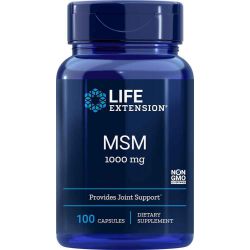MSM - The Multi-Purpose Compound
 MSM (methyl-sulfonyl-methane), also known as dimethyl sulfone, is a naturally occurring sulfur compound, found in human diets and those of virtually all other vertebrates. In its purified form, it is an odorless, slightly bitter tasting, water soluble, white, crystalline powder containing 34% elemental sulfur. Its chemical formula is (CH3)2SO2.
MSM (methyl-sulfonyl-methane), also known as dimethyl sulfone, is a naturally occurring sulfur compound, found in human diets and those of virtually all other vertebrates. In its purified form, it is an odorless, slightly bitter tasting, water soluble, white, crystalline powder containing 34% elemental sulfur. Its chemical formula is (CH3)2SO2.
Some atmospheric chemists have suggested that MSM and its related compounds, DMSO (dimethylsulfoxide), and DMS (dimethylsulfide) provide the source for 85% of sulfur compounds in all living organisms. These naturally occurring compounds begin in the ocean where phytoplankton convert inorganic sulfur present in the sea water to terniary dimethyl sulfonium salts. These salts are later broken down, by enzymatic action, into the volatile compound called dimethylsulfide (DMS), which escapes the ocean as a gas, rises into the upper atmosphere to be oxidized there in the presence of ozone and ultraviolet light to its chemical cousins, DMSO and MSM. Unlike DMS, both DMSO and MSM are water soluble and are returned to the earth in rain. Plants rapidly absorb the two compounds, concentrating them up to a hundred-fold. Animals eat the plants and the distribution of these sulfur compounds is then complete. MSM has been found in the blood and adrenal glands of cows. Cows' milk contains between two and six parts per million MSM.
MSM occurs naturally in the human body as a result of the food we eat. It is a normal component of fresh fruits, vegetables, seafood and meat. It has also been found in tea, coffee and chocolate. It has been detected in normal human urine. The amount of MSM present in the circulatory system of an adult human male is about 0.2 parts per million. Normal adult humans excrete from four to eleven milligrams of MSM per day in their urine. In vertebrates, the concentration of MSM decreases with age. Some research suggests that there is a minimum concentration of MSM that must be maintained in the body to preserve normal function and structure.
Experiments using MSM that contains radiolabled sulfur (35S) have shown that after ingestion, MSM gives up its sulfur to the essential amino acids methionine, cysteine and other serum proteins, eventually finding its way into the collagen of skin, joints and blood vessels. It is also incorporated into the keratin of hair and nails.
MSM is rated as one of the least toxic substances in biology. It is so inert and nontoxic that aqueous solutions can even be used as a blood diluent. In mice, no clinical changes were observed at oral doses of 2000 mg per kilogram of body weight. The lethal dose (LD50) of MSM for mice is over 20 grams per kilogram of body weight. Hundreds of patients have been treated at the Oregon Health Sciences University with oral MSM at levels above two grams daily for many years without serious toxicity.
Scientists don't yet know all the functions of MSM in the human body, but at the Oregon Health Sciences University the following conditions have responded well to supplemental MSM:
- Allergy Response to pollens and foods is sharply curtailed. Medication may be reduced or eliminated.
- Control of hyperacidity. Patients who have used antacids and histamine-receptor antagonists to control hyperacidity can employ MSM with excellent results.
- Relief from constipation. Patients with chronic constipation have had prompt and continuing relief with a daily supplement of MSM.
 Research done at Ohio State University College of Medicine showed that oral MSM can protect rats against the onset of breast cancer.
Research done at Ohio State University College of Medicine showed that oral MSM can protect rats against the onset of breast cancer.
Rats bred to be susceptible to breast cancer when given certain carcinogenic compounds were fed a diet containing added MSM for eight days. Following this period the rats were given 15 mg doses of 7,12-dimethylbenzanthracene by oral gastric intubation. The health of the rats was monitored for nearly one year and compared to a similar group of carcinogen-dosed rats that had not received the MSM diet. Although there was no statistical difference in the number of tumors developing in the two groups, the MSM diet rats developed their first tumors 100 days later than the non-MSM diet rats, and these tumors became cancerous about 130 days later than those in the control group.
The same researchers from the Ohio State University College of Medicine also studied the protection that dietary MSM provided rats injected with 1,2-dimethylhydrazine, a compound that induces colon cancer. One group of rats received MSM as a 1% solution in their drinking water during the experiment. The control group received only tap water. One week after the start of the dietary regimen, all rats were injected with the carcinogen. At two-month intervals the rats were examined under anesthesia for tumors. Rats without any appearance of tumors were returned to the experiment. Again, the number of bowel tumors occurring in the rats was statistically the same for treated and untreated rats over the entire nine-month experiment. However, the time of appearance of the first bowel tumors was considerably longer in the MSM treated rats. The conclusion of the researchers was that MSM significantly lengthens the time of tumor onset compared to controls and MSM should be further investigated as a preventive for colon cancer.
Researchers at Oregon Health Sciences University studied a strain of mice that were prone to spontaneous development of joint lesions similar to those in rheumatoid arthritis. They found that animals fed a diet that included a 3% solution of MSM, in drinking water from the age of two months until the age of five months, suffered no degeneration of articular cartilage. In the control group of mice receiving only tap water, 50% of the animals were found to have focal degeneration of articular cartilage.
Finally, recent human research at the UCLA School of Medicine found an 82% reduction in pain after six weeks of oral MSM use in a double blind study on degenerative arthritis. The study spanned four months and involved sixteen patients: ten patients on MSM and six on placebo. After only six weeks, those patients using the MSM experienced better than 80% control of their pain, while those on the placebo experienced on average an 18% improvement at six weeks.
Material used with permission of Life Extension. All rights reserved.
Herschler, R. J., U.S. Patent No. 4,973,605, Nov. 27, 1990.
Istituto di Ricerche Biomediche, RBM EXP., No. 980174, Aug. 19, 1998.
Jacob, J.W. and Herschler, R., Ann. N.Y. Acad. Sci., Vol. 411, xiii, 1983.
Jacob, S.W., Oregon Health Sciences University, Portland, Oregon, personal communication.
Lawrence, R. M., U.C.L.A. School of Medicine, Methyl-Sulfonyl-Methane, A Preliminary Correspondence.
Lovelock, J.E. et al., Nature, Vol. 237, 452, 1972.
McCabe, D. et al., Arch. Surg., Vol. 121, 1455, 1986.
Morton, J. I. andamp; Moore, R. D., Federation of American Societies for Experimental Biology, 69th Annual Meeting, April 21-26, 1985, 692, 1985.
O’Dwyer, P.J. et al., Cancer, Vol. 62, 944, 1988.
Richmond, V. L., J. Nutrition, Vol. 116, No. 6, June 1986.
Williams, K.I.H. et al., Arch. Biochem. Biophys., Vol. 113, 251, 1966.
Williams, K.I.H. et al., Proc. Exp. Biol. andamp; Med., Vol. 122, 865, 1966.


